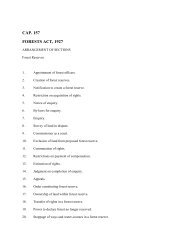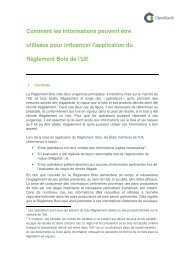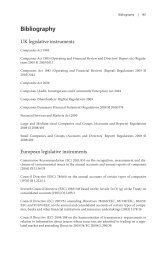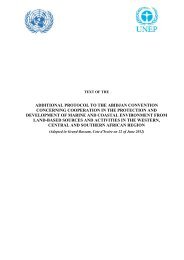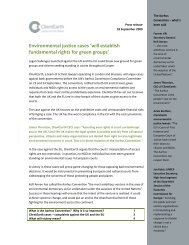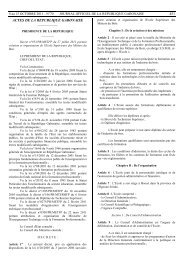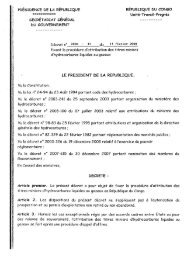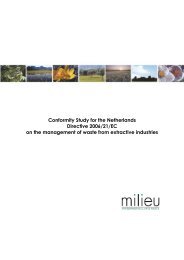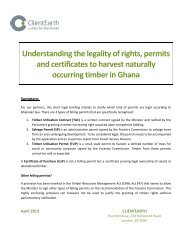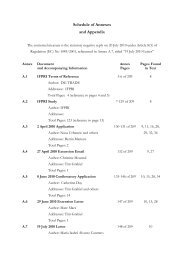Environmental and social transparency under the ... - ClientEarth
Environmental and social transparency under the ... - ClientEarth
Environmental and social transparency under the ... - ClientEarth
- No tags were found...
Create successful ePaper yourself
Turn your PDF publications into a flip-book with our unique Google optimized e-Paper software.
178 | <strong>Environmental</strong> <strong>and</strong> <strong>social</strong> <strong>transparency</strong> <strong>under</strong> <strong>the</strong> Companies Act 2006Notes | 179278AccountancyAge reported that “Confusion <strong>and</strong> fury from across <strong>the</strong> business communityhas met Gordon Brown’s decision to drop <strong>the</strong> m<strong>and</strong>atory operating <strong>and</strong> financialreview.” (Paul Grant, ‘Anger as OFR falls victim to Brown’s red tape blitz’ AccountancyAge(1 December 2005)). Charles Tilley, chief executive of <strong>the</strong> Chartered Institute of ManagementAccountants commented that “The drive to reduce <strong>the</strong> burden of red tape on businessis a laudable one, but we believe wholeheartedly in <strong>the</strong> value of <strong>the</strong> OFR. Confusing <strong>the</strong> OFRwith a reduction in bureaucracy risks losing <strong>the</strong> benefits it will deliver to all stakeholders,particularly shareholders. That would be <strong>the</strong> wrong step <strong>and</strong> a fundamentally bad one”(CIMA Press Release, ‘CIMA expresses disappointment at Chancellor’s plans to scrap m<strong>and</strong>atoryOFR’, 28 November 2005).279The main losses in substantive requirements were that <strong>the</strong> OFR explicitly required: <strong>the</strong>report to be ‘prepared so as to assist <strong>the</strong> members of <strong>the</strong> company to assess <strong>the</strong> strategiesadopted by <strong>the</strong> company <strong>and</strong> <strong>the</strong> potential for those strategies to succeed’ (Section 1); thatinformation about environmental matters should include ‘<strong>the</strong> impact of <strong>the</strong> business of<strong>the</strong> company on <strong>the</strong> environment’ (Section 4), to <strong>the</strong> extent necessary to comply with <strong>the</strong>general requirements of paragraphs 1 <strong>and</strong> 2; <strong>the</strong> review to (a) state whe<strong>the</strong>r it had beenprepared in accordance with relevant reporting st<strong>and</strong>ards, <strong>and</strong> (b) contain particulars of,<strong>and</strong> reasons for, any departure from such st<strong>and</strong>ards (Section 8). However, while not explicitin <strong>the</strong> business review, each of <strong>the</strong>se requirements are still implicitly necessary to fulfil <strong>the</strong>o<strong>the</strong>r obligations <strong>under</strong> <strong>the</strong> Companies Act 2006. The fur<strong>the</strong>r losses were <strong>the</strong> incidentalmentions of matters in paragraphs 34 <strong>and</strong> 37 of <strong>the</strong> ASB’s Reporting St<strong>and</strong>ard 1.280EASC, ‘Operating <strong>and</strong> Financial Review (OFR) Regulations: Proposal to roll-back to EUminima: Note to Chancellor’, 11 November 2005.Annex 3281See, for explanation, Case 152/84 Marshall v Southampton <strong>and</strong> South West HampshireAHA [1986] IRLR 140.282Council Directive (EEC) 78/660 on <strong>the</strong> annual accounts of certain types of companies[1978] OJ L222/11.283Council Directive (EC) 2003/51 amending Directives 78/660/EEC, 83/349/EEC, 86/635/EEC <strong>and</strong> 91/674/EEC on <strong>the</strong> annual <strong>and</strong> consolidated accounts of certain types of companies,banks <strong>and</strong> o<strong>the</strong>r financial institutions <strong>and</strong> insurance <strong>under</strong>takings [2003] OJL178/16.284Council Directive (EC) 2004/109 on <strong>the</strong> harmonisation of <strong>transparency</strong> requirements inrelation to information about issuers whose securities are admitted to trading on a regulatedmarket <strong>and</strong> amending Directive 2001/34/EC [2004] OJ L390/38.285Commission Recommendation (EC) 2001/453 on <strong>the</strong> recognition, measurement <strong>and</strong>disclosure of environmental issues in <strong>the</strong> annual accounts <strong>and</strong> annual reports of companies[2001] OJ L156/33.286See also <strong>the</strong> Seventh Council Directive (EEC) 1983/349 based on <strong>the</strong> Article 54 (3) (g) of<strong>the</strong> Treaty on consolidated accounts [1983] OJ L193/1.287‘Recitals’ are <strong>the</strong> paragraphs which preface <strong>the</strong> body of <strong>the</strong> legislation, giving context toit.288London Stock Exchange, ‘RNS <strong>and</strong> <strong>the</strong> new Transparency Directive’ (December 2006),p. 4.289Directive ‘recitals’ have no independent legal value <strong>and</strong> do not need to appear in <strong>the</strong>national legislation transposing <strong>the</strong> Directive. However, in case of litigation, <strong>the</strong> courtscan take <strong>the</strong>m into consideration to ascertain <strong>the</strong> Council’s intention when drafting certainArticles.Annex 4290ss 475, 495, 496, 497 Companies Act 2006.291s 437(3) Companies Act 2006.292BERR, ‘Companies Act 2006: Regulatory Impact Assessment’ (January 2007) p. 17.293Up to this point, <strong>the</strong>re has not been uniformity in reporting in terms of structure; notall reports explicitly lay <strong>the</strong>ir environmental or <strong>social</strong> reporting within a ‘business review’or ‘directors’ report’, even where it is included in <strong>the</strong> same document. For <strong>the</strong> purpose ofcomparative performance assessment, this renders <strong>the</strong>m extremely unhelpful (confirmedby research team at Rathbone Greenbank in interview, 15 October 2008). How <strong>the</strong> introductioninto force of section 417 Companies Act 2006 affects this remains to be seen.294ACCA website, ‘The future of sustainability assurance’ (accessed Nov 2009) .295For example, AccountAbility, a leading assurance provider <strong>and</strong> author of <strong>the</strong> AA1000Assurance St<strong>and</strong>ard, describes <strong>the</strong> process as follows: “Assurance is defined broadly interms of its outcome as: enabling <strong>the</strong> confidence of a party or group of people that <strong>the</strong>information <strong>the</strong>y have is accurate <strong>and</strong> complete enough for <strong>the</strong>m to make an informeddecision about a certain subject matter”. Quoted from PricewaterhouseCoopers, ‘The RightCombination*: Corporate Responsibility reports: <strong>the</strong> role of assurance providers <strong>and</strong> stakeholderpanels’ (December 2007) p. 15.296KPMG Global Sustainability Services, ‘KPMG International Survey of CorporateResponsibility Reporting 2005’ (June 2005).297National top 100 companies.298Averaged across 16 countries.299Indeed only Italy demonstrated a higher proportion of corporate responsibility reportswith audit statements in N100 companies.300It is important to note that <strong>the</strong>se observations are not UK-specific, but regardless <strong>the</strong>ygive some indication of <strong>the</strong> l<strong>and</strong>scape in this uncertain area.



